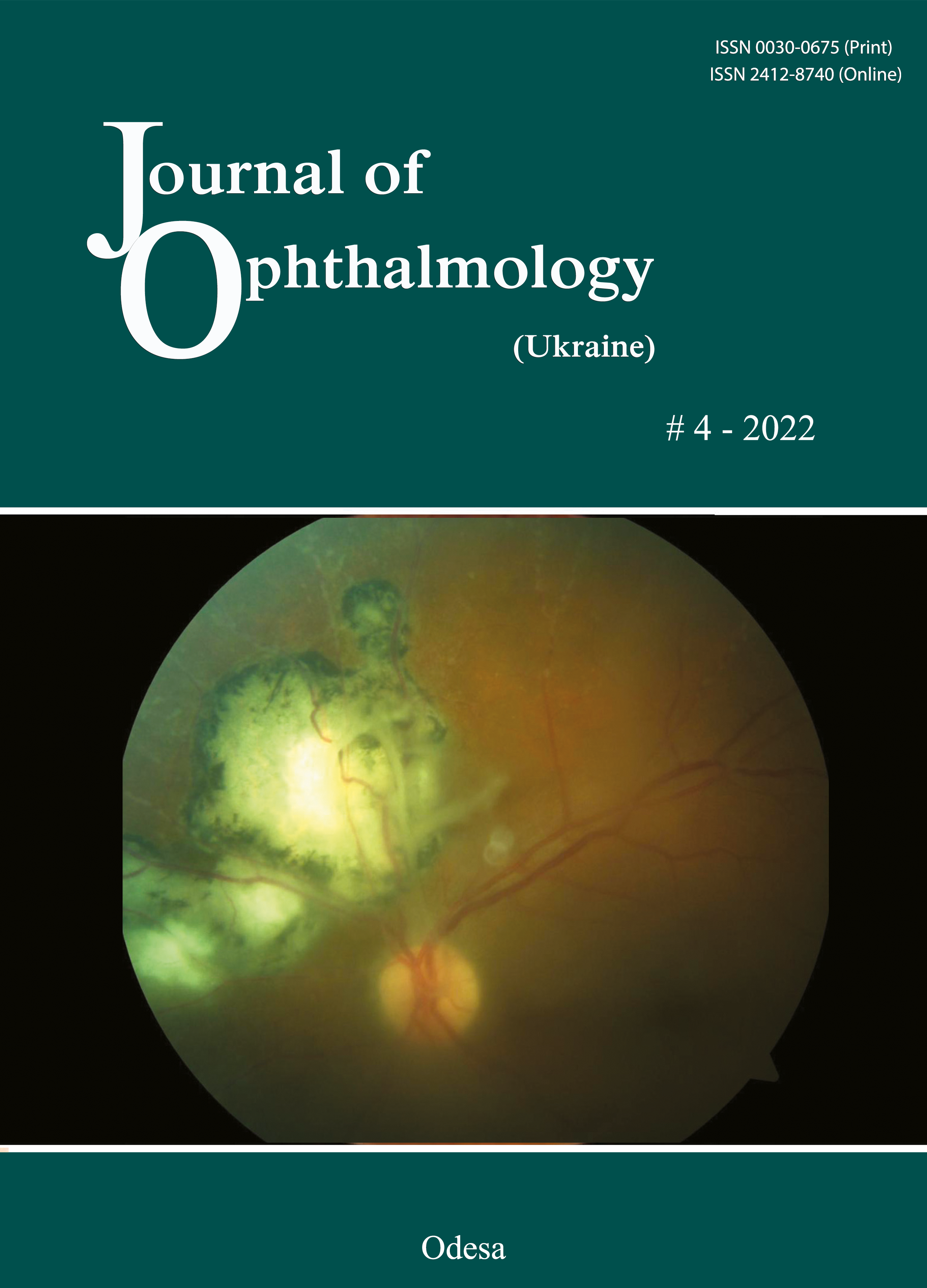Features of visual disturbances in patients with newly diagnosed acromegalia
DOI:
https://doi.org/10.31288/oftalmolzh202242832Keywords:
pituitary adenoma, acromegaly, structural and functional classification, compressive optic neuropathy, endoscopic transnasal surgeryAbstract
Background: Acromegaly is a complex neuroendocrinologic disorder associated with hypersecretion of growth hormone (GH) and insulin-like growth factor (IGF-1) in individuals with completed physiological growth. The cause is, most commonly, an autonomously functioning pituitary adenoma (PA) secreting GH only or GH in combination with prolactin. Cuevas-Ramos and colleagues identified three structural and functional acromegaly types distinguished by clinical course, direction of tumor extension, tumor aggressiveness, expression profile of somatotroph surface receptors and potential responsiveness to treatment.
Purpose: To review the features of visual disturbances in patients with newly diagnosed acromegaly.
Material and Methods: We retrospectively reviewed the medical records of 174 patients with newly diagnosed acromegaly who underwent endoscopic transnasal transsphenoidal surgery for PA at the Transsphenoidal Neurosurgery Department of the Romodanov Institute during 2018 through 2011. In all patients, the diagnosis of PA was confirmed by a comprehensive morphological study. Of the 174 patients, 11.5% (20 patients; 40 eyes) had visual disturbances (reduced visual acuity and/or visual field defects) and were included in the visual disturbance group. Patients underwent clinical and neurological, endocrinological and eye examination and neuroimaging studies.
Results: Visual disturbances were found preoperatively in 20 (11.5%) of the 174 consecutive patients with PA secreting GH only. Of the 20 cases, 17 (85%) were classified as type 3, and 3 (15%), as type 2 according to the structural and functional acromegaly classification of Cuevas-Ramos et al. Suprasellar extension of the pituitary adenoma towards the optic nerve-chiasm complex and compression of the crossed optic nerve fibers caused symmetric chiasmal syndrome in 11 (55%) and primary descending optic atrophy in 14 (70%) patients. After treatment, the numbers of eyes with severe and very severe visual acuity loss reduced by 5% and 7.5%, respectively, and a reduction in visual field defects was observed in 12.5% of eyes.
Conclusion: We believe that the application of the structural and functional acromegaly classification by Cuevas-Ramos and colleagues would be useful not only for assessing whether a multimodal approach (comprising neurosurgery, medical therapy and radiotherapy) is required, but also for predicting the risk of developing visual disturbances in a particular case of acromegaly.
References
1.Kovacs K, Horvath E. Tumors of the pituitary gland. Atlas of Tumor Pathology, series 2, vol. 21. Washington: Armed Forces Institute of Pathology. 1986.
2.Melmed S, Bronstein MD, Chanson P, Klibanski A, Casanueva FF, Wass J, et al. A Consensus Statement on acromegaly therapeutic outcomes. Nature reviews. Endocrinology. 2018; 14(9), 552-561. https://doi.org/10.1038/s41574-018-0058-5
3.Fleseriu M, Biller B, Freda PU, Gadelha MR, Giustina A, Katznelson L, et al. A Pituitary Society update to acromegaly management guidelines. Pituitary. 2021; 24(1), 1-13. https://doi.org/10.1007/s11102-020-01091-7
4.Giustina A. Barkhoudarian G, Beckers A, Ben-Shlomo A, Biermasz N, Biller B, et al. "Multidisciplinary management of acromegaly: A consensus." Rev Endocr Metab Disord. 2020: 21(4), 667-678. https://doi.org/10.1007/s11154-020-09588-z
5.Taweesomboonyat C, Oearsakul T. Prognostic Factors of Acromegalic Patients with Growth Hormone-Secreting Pituitary Adenoma After Transsphenoidal Surgery. World Neurosurg. 2021;146: e1360-e1366. https://doi.org/10.1016/j.wneu.2020.12.013
6.Ritchie CM, Atkinson AB, Kennedy AL, Lyons AR, Gordon DS, Fannin T, Hadden DR. Ascertainment and natural history of treated acromegaly in Northern Ireland. Ulster Med J. 1990; 59(1): 55-62.
7.Lavrentaki A, Paluzzi A, Wass J, Karavitaki N. Epidemiology of acromegaly: review of population studies. Pituitary. 2017;20(1):4-9. https://doi.org/10.1007/s11102-016-0754-x
8.Daly A, Rixhon M, Adam C, Dempegioti A, Tichomirowa M, Beckers A. High prevalence of pituitary adenomas: a cross-sectional study in the province of Liege, Belgium. J Clin Endocrinol Metab. 2006;91(12):4769-75. https://doi.org/10.1210/jc.2006-1668
9.Holdaway I M, Bolland MJ, Gamble GD. A meta-analysis of the effect of lowering serum levels of GH and IGF-I on mortality in acromegaly. Eur J Endocrinol. 2008; 159(2):89-95. https://doi.org/10.1530/EJE-08-0267
10.Khizhnyak O, Barabash N, Mikityuk M, Nikolaev R, Gogitidze T. Clinical and hormonal features of acromegaly in patients from a Ukrainian neuroendocrinology centre. Probl Endocrine Pathol. 2018; 65(3):67-74. https://doi.org/10.21856/j-PEP.2018.3.08
11.Trainer P. J. ACROSTUDY: an overview. Horm Res. 2007; 68 (5); 68-69. https://doi.org/10.1159/000110480
12.Abouaf L, Vighetto A, Lebas M. Neuro-ophthalmologic exploration in non-functioning pituitary adenoma. Ann Endocrinol (Paris). 2015; 76(3):210-9. https://doi.org/10.1016/j.ando.2015.04.006
13.Foroozan R. Chiasmal syndromes. Curr. Opin. Ophthalmol. 2003; 14(6):325-31. https://doi.org/10.1097/00055735-200312000-00002
14.Kitthaweesin K, Ployprasith C. Ocular manifestations of suprasellar tumors. J Med Assoc Thai. 2008; 91(5):711-5.
15.Wadud SA, Ahmed S, Choudhury N, Chowdhury D. Evaluation of ophthalmic manifestations in patients with intracranial tumours. Mymensingh Med J. 2014; 23(2):268-71.
16.Sefi-Yurdakul N. Visual findings as primary manifestations in patients with intracranial tumors. Int J Ophthalmol. 2015; 8(4):800-3. DOI: 10.3980/j.issn.2222-3959.2015.04.28. eCollection 2015.
17.Cardinal T, Rutkowski M, Micko A, Shiroishi M, Jason Liu C, Wrobel B, et al.Impact of tumor characteristics and pre- and postoperative hormone levels on hormonal remission following endoscopic transsphenoidal surgery in patients with acromegaly. Neurosurg Focus. 2020; 48(6):E10. https://doi.org/10.3171/2020.3.FOCUS2080
18.Cuevas-Ramos D, Carmichael J, Cooper O, Bonert V, Gertych A, Mamelak A, Melmed S. A structural and functional acromegaly classification. J Clin Endocrinol Metab. 2015;100(1):122-131. https://doi.org/10.1210/jc.2014-2468
19.Hennessey JV, Jackson IM. Clinical features and differential diagnosis of pituitary tumours with emphasis on acromegaly. Baillieres Clin Endocrinol Metab. 1995;9(2):271-314. https://doi.org/10.1016/S0950-351X(95)80338-6
20.Rivoal O, Brézin AP, Feldman-Billard S, Luton JP. Goldmann perimetry in acromegaly: a survey of 307 cases from 1951 through 1996. Ophthalmology. 2000; 107(5):991-7. https://doi.org/10.1016/S0161-6420(00)00060-9
21.Lee A. G. Acromegaly and junctional visual field loss. Ophthalmology. 2001; 108(5), 832-833. https://doi.org/10.1016/S0161-6420(00)00455-3
Downloads
Published
How to Cite
Issue
Section
License
Copyright (c) 2025 К. С. Єгорова, Л. В. Задояний, М. О. Гук, О. Є. Скобська, М. Л. Соловей, О. Г. Черненко, Б. Б. Гуда

This work is licensed under a Creative Commons Attribution 4.0 International License.
This work is licensed under a Creative Commons Attribution 4.0 International (CC BY 4.0) that allows users to read, download, copy, distribute, print, search, or link to the full texts of the articles, or use them for any other lawful purpose, without asking prior permission from the publisher or the author as long as they cite the source.
COPYRIGHT NOTICE
Authors who publish in this journal agree to the following terms:
- Authors hold copyright immediately after publication of their works and retain publishing rights without any restrictions.
- The copyright commencement date complies the publication date of the issue, where the article is included in.
DEPOSIT POLICY
- Authors are permitted and encouraged to post their work online (e.g., in institutional repositories or on their website) during the editorial process, as it can lead to productive exchanges, as well as earlier and greater citation of published work.
- Authors are able to enter into separate, additional contractual arrangements for the non-exclusive distribution of the journal's published version of the work with an acknowledgement of its initial publication in this journal.
- Post-print (post-refereeing manuscript version) and publisher's PDF-version self-archiving is allowed.
- Archiving the pre-print (pre-refereeing manuscript version) not allowed.












